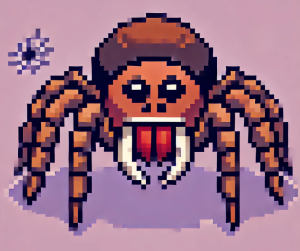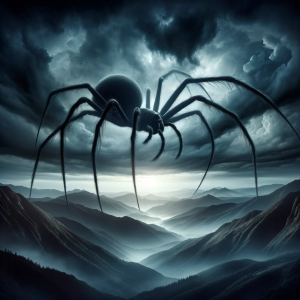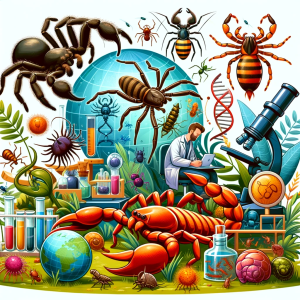
Venomless Spiders?
Imagine you’re a spider (if you’re a nut), perched delicately in your web, waiting for a meal to stumble into your silken trap. Now, picture yourself without one of the key tools most spiders rely on: venom. How would you survive?
This is the reality for the Uloboridae family of spiders, who have developed a fascinating and unique way of capturing prey without the use of venom. A recent study has shed light on the genetic adaptations that allow these venomless spiders to thrive, offering a glimpse into the incredible adaptability of nature.
The Unconventional Hunters
When we think of spiders, the image of venomous fangs often comes to mind (along with 1990’s Arachnophobia). For most of the arachnid world, venom is a vital tool for subduing prey. It’s efficient, fast, and allows spiders to immobilize their victims with a single bite. But the Uloboridae family, which includes the spider Octonoba sinensis, has taken a different evolutionary path. Instead of relying on venom, these spiders have perfected the art of prey-wrapping.
Using their silk, Uloboridae spiders wrap their prey with extraordinary precision and patience. This process can take several minutes—much longer than the swift venomous strike of their cousins. But this physical method works just as well, if not better, in some situations. The prey, once fully encased in silk, is rendered helpless, allowing the spider to consume it at leisure. This unique behavior is not just a quirky anomaly; it’s a testament to the power of adaptation and survival.
The Genetic Blueprint of Adaptation
To understand how these spiders thrive without venom, scientists embarked on a deep dive into the genome of Octonoba sinensis. By comparing its genetic makeup with other spiders, the researchers uncovered a fascinating array of adaptations that have allowed these creatures to excel in their venom-free lifestyle.
One of the most significant findings was the role of muscle-related genes in these spiders. The study revealed that genes related to muscle movements, such as myosin and twitching, have undergone positive selection in Octonoba sinensis. This means that over generations, these genes have evolved to enhance the spider’s physical capabilities, enabling it to produce the vast amounts of silk needed for prey-wrapping and to sustain long periods of activity during the wrapping process.
Moreover, these spiders exhibit enhanced energy metabolism functions. The genes associated with aerobic respiration—how cells use oxygen to produce energy—are more active in Uloboridae spiders. This allows them to maintain high energy levels during the physically demanding process of capturing prey without the aid of venom.
Building Strength from Within
The study also found that gene families related to tracheal development and tissue strength have expanded in these spiders. The tracheal system in spiders functions similarly to our respiratory system, allowing for efficient oxygen exchange. In Octonoba sinensis, this system is particularly well-developed, supporting the spider’s increased physical activity. This adaptation is crucial for a spider that relies on wrapping prey for extended periods.
Additionally, genes related to the structural components of connective tissues have expanded. These genes are responsible for producing proteins that contribute to the spider’s physical resilience, giving it the strength to endure the demands of its unique hunting strategy.
A Trade-Off in Evolution
Perhaps the most intriguing aspect of this research is the idea of an evolutionary trade-off. The absence of venom glands in Uloboridae spiders might seem like a disadvantage, but this study highlights how nature compensates for such losses. By enhancing physical traits like muscle strength, energy metabolism, and respiratory efficiency, these spiders have found a different way to thrive.
The research also suggests that some genes, which are involved in producing toxins in venomous spiders, may have shifted function in Uloboridae spiders. Instead of contributing to venom production, these genes may now play a role in other biological processes, further illustrating the remarkable flexibility of evolution.
The Bigger Picture
So, why should we care about a spider that doesn’t have venom? Beyond the sheer wonder of their survival strategies, this research offers broader insights into the adaptability of life. In a world where change is constant, the ability to adjust and find new ways to survive is a theme that resonates across all species, including our own.
These spiders teach us that there is no single path to success. Whether it’s through brute force, cunning strategies, or, in this case, silk-wrapping precision, life finds a way. The Uloboridae family of spiders may not have the fearsome reputation of their venomous relatives. Still, their story is one of ingenuity and resilience, reminding us of the endless possibilities that evolution can bring.
Join the Conversation
What do you think about the idea of an evolutionary trade-off? Can you think of other examples in nature where a loss of one trait leads to the enhancement of another? How might this concept apply to human adaptation in the face of changing environments?
Feel free to share your thoughts in the comments below. Let’s explore the wonders of evolution together!
Transform Your Science World:
Get the latest and most inspiring scientific updates with ‘This Week in Science’! Perfect for educators and science enthusiasts, our free weekly newsletter delivers groundbreaking research and stories that ignite your passion for learning and teaching. Sign up today and transform your approach to science. If you liked this blog, please share it! Your referrals help This Week in Science reach new readers.



